Stress Distribution in Radicular Dentin with Different Post and Core Materials: A 3D Finite Element Analysis
Abstract
1. Introduction
2. Materials and Methods
3. Results
4. Discussion
5. Conclusions
Author Contributions
Funding
Institutional Review Board Statement
Informed Consent Statement
Data Availability Statement
Conflicts of Interest
References
- James, S.L.; Abate, D.; Abate, K.H.; Abay, S.M.; Abbafati, C.; Abbasi, N.; Abbastabar, H.; Abd-Allah, F.; Abdela, J.; Abdelalim, A.; et al. Global, regional, and national incidence, prevalence, and years lived with disability for 354 diseases and injuries for 195 countries and territories, 1990–2017: A systematic analysis for the Global Burden of Disease Study 2017. Lancet 2018, 392, 1789–1858. [Google Scholar] [CrossRef]
- Pierrisnard, L.; Bohin, F.; Renault, P.; Barquins, M. Corono-radicular reconstruction of pulpless teeth: A mechanical study using finite element analysis. J. Prosthet. Dent. 2002, 88, 442–448. [Google Scholar] [CrossRef] [PubMed]
- Juloski, J.; Apicella, D.; Ferrari, M. The effect of ferrule height on stress distribution within a tooth restored with fibre posts and ceramic crown: A finite element analysis. Dent. Mater. 2014, 30, 1304–1315. [Google Scholar] [CrossRef] [PubMed]
- Batista, V.E.d.S.; Bitencourt, S.B.; Bastos, N.A.; Pellizzer, E.P.; Goiato, M.C.; dos Santos, D.M. Influence of the ferrule effect on the failure of fiber-reinforced composite post-and-core restorations: A systematic review and meta-analysis. J. Prosthet. Dent. 2020, 123, 239–245. [Google Scholar] [CrossRef] [PubMed]
- Ichim, I.; Kuzmanovic, D.V.; Love, R.M. A finite element analysis of ferrule design on restoration resistance and distribution of stress within a root. Int. Endod. J. 2006, 39, 443–452. [Google Scholar] [CrossRef]
- Oyar, P. The effects of post-core and crown material and luting agents on stress distribution in tooth restorations. J. Prosthet. Dent. 2014, 112, 211–219. [Google Scholar] [CrossRef]
- Lima, M.O.; Ferretti, M.A.; Caldas, R.A.; BarÃO, V.A.R.; FranÇA, F.M.G.; Lima, D.A.N.L.; Martins, L.R.; Aguiar, F.H.B. Application of polyetheretherketone (PEEK) posts: Evaluation of fracture resistance and stress distribution in the root: In vitro and finite element analyses. Braz. Oral Res. 2023, 37, e047. [Google Scholar] [CrossRef]
- Corrêa, G.; Brondani, L.P.; Wandscher, V.F.; Pereira, G.K.R.; Valandro, L.F.; Bergoli, C.D. Influence of remaining coronal thickness and height on biomechanical behavior of endodontically treated teeth: Survival rates, load to fracture and finite element analysis. J. Appl. Oral Sci. 2018, 26, e20170313. [Google Scholar] [CrossRef]
- Fernandes, A.S.; Dessai, G.S. Factors affecting the fracture resistance of post-core reconstructed teeth: A review. Int. J. Prosthodont. 2001, 14, 355–363. [Google Scholar]
- Zicari, F.; Van Meerbeek, B.; Scotti, R.; Naert, I. Effect of ferrule and post placement on fracture resistance of endodontically treated teeth after fatigue loading. J. Dent. 2013, 41, 207–215. [Google Scholar] [CrossRef]
- Ausiello, P.; Ciaramella, S.; Martorelli, M.; Lanzotti, A.; Zarone, F.; Watts, D.C.; Gloria, A. Mechanical behavior of endodontically restored canine teeth: Effects of ferrule, post material and shape. Dent. Mater. 2017, 33, 1466–1472. [Google Scholar] [CrossRef] [PubMed]
- Santos-Filho, P.C.F.; Veríssimo, C.; Raposo, L.H.A.; Noritomi, M.P.Y.; Marcondes Martins, L.R. Influence of Ferrule, Post System, and Length on Stress Distribution of Weakened Root-filled Teeth. J. Endod. 2014, 40, 1874–1878. [Google Scholar] [CrossRef] [PubMed]
- Feng, J.; Chai, M.; Zhang, K.; Liu, J.; Li, X. Influence of restorative materials on the mechanical properties of maxillary first molars with different degrees of cryptic fractures and defects: A finite element analysis. Dent. Mater. J. 2024, 43, 97–105. [Google Scholar] [CrossRef]
- Mamoun, J.S. On the ferrule effect and the biomechanical stability of teeth restored with cores, posts, and crowns. Eur. J. Dent. 2019, 08, 281–286. [Google Scholar] [CrossRef]
- Sorensen, J.A.; Engelman, M.J. Ferrule design and fracture resistance of endodontically treated teeth. J. Prosthet. Dent. 1990, 63, 529–536. [Google Scholar] [CrossRef]
- Juloski, J.; Radovic, I.; Goracci, C.; Vulicevic, Z.R.; Ferrari, M. Ferrule Effect: A Literature Review. J. Endod. 2012, 38, 11–19. [Google Scholar] [CrossRef]
- Rodrigues, M.d.P.; Soares, P.B.F.; Valdivia, A.D.C.M.; Pessoa, R.S.; Veríssimo, C.; Versluis, A.; Soares, C.J. Patient-specific Finite Element Analysis of Fiber Post and Ferrule Design. J. Endod. 2017, 43, 1539–1544. [Google Scholar] [CrossRef]
- Jotkowitz, A.; Samet, N. Rethinking ferrule—A new approach to an old dilemma. Br. Dent. J. 2010, 209, 25–33. [Google Scholar] [CrossRef]
- Santana, F.R.; Castro, C.G.; Simamoto-Júnior, P.C.; Soares, P.V.; Quagliatto, P.S.; Estrela, C.; Soares, C.J. Influence of post system and remaining coronal tooth tissue on biomechanical behaviour of root filled molar teeth. Int. Endod. J. 2011, 44, 386–394. [Google Scholar] [CrossRef]
- Savychuk, A.; Manda, M.; Galanis, C.; Provatidis, C.; Koidis, P. Stress generation in mandibular anterior teeth restored with different types of post-and-core at various levels of ferrule. J. Prosthet. Dent. 2018, 119, 965–974. [Google Scholar] [CrossRef]
- Nokar, S.; Bahrami, M.; Mostafavi, A.S. Comparative Evaluation of the Effect of Different Post and Core Materials on Stress Distribution in Radicular Dentin by Three-Dimensional Finite Element Analysis. J. Dent. 2018, 15, 69–78. [Google Scholar]
- Arunpraditkul, S.; Saengsanon, S.; Pakviwat, W. Fracture Resistance of Endodontically Treated Teeth: Three Walls versus Four Walls of Remaining Coronal Tooth Structure. J. Prosthodont. 2008, 18, 49–53. [Google Scholar] [CrossRef]
- Dejak, B.; Młotkowski, A. The influence of ferrule effect and length of cast and FRC posts on the stresses in anterior teeth. Dent. Mater. 2013, 29, e227–e237. [Google Scholar] [CrossRef] [PubMed]
- Tekin, S.; Adiguzel, O.; Cangul, S.; Atas, O.; Erpacal, B. Evaluation of the use of PEEK material in post-core and crown restorations using finite element analysis. Am. J. Dent. 2020, 33, 251–257. [Google Scholar] [PubMed]
- Lee, K.-S.; Shin, J.-H.; Kim, J.-E.; Kim, J.-H.; Lee, W.-C.; Shin, S.-W.; Lee, J.-Y. Corrigendum to “Biomechanical Evaluation of a Tooth Restored with High Performance Polymer PEKK Post-Core System: A 3D Finite Element Analysis”. BioMed Res. Int. 2017, 2017, 1373127. [Google Scholar] [CrossRef]
- Nahar, R.; Mishra, S.K.; Chowdhary, R. Evaluation of stress distribution in an endodontically treated tooth restored with four different post systems and two different crowns—A finite element analysis. J. Oral Biol. Craniofacial Res. 2020, 10, 719–726. [Google Scholar] [CrossRef]
- Ibrahim, R.O.; Al-Zahawi, A.R.; Sabri, L.A. Mechanical and thermal stress evaluation of PEEK prefabricated post with different head design in endodontically treated tooth: 3D-finite element analysis. Dent. Mater. J. 2021, 40, 508–518. [Google Scholar] [CrossRef]
- Özarslan, M.; Büyükkaplan, U.; Özarslan, M.M.; Türker, N.; Çelik, H.K. Finite Element Stress Analysis of PEEK, Glass Fiber and Zirconia Post-Core Sys-tems in Maxillary Central Incisor. Van Sağlık Bilim. Derg. 2021, 14, 180–190. [Google Scholar] [CrossRef]

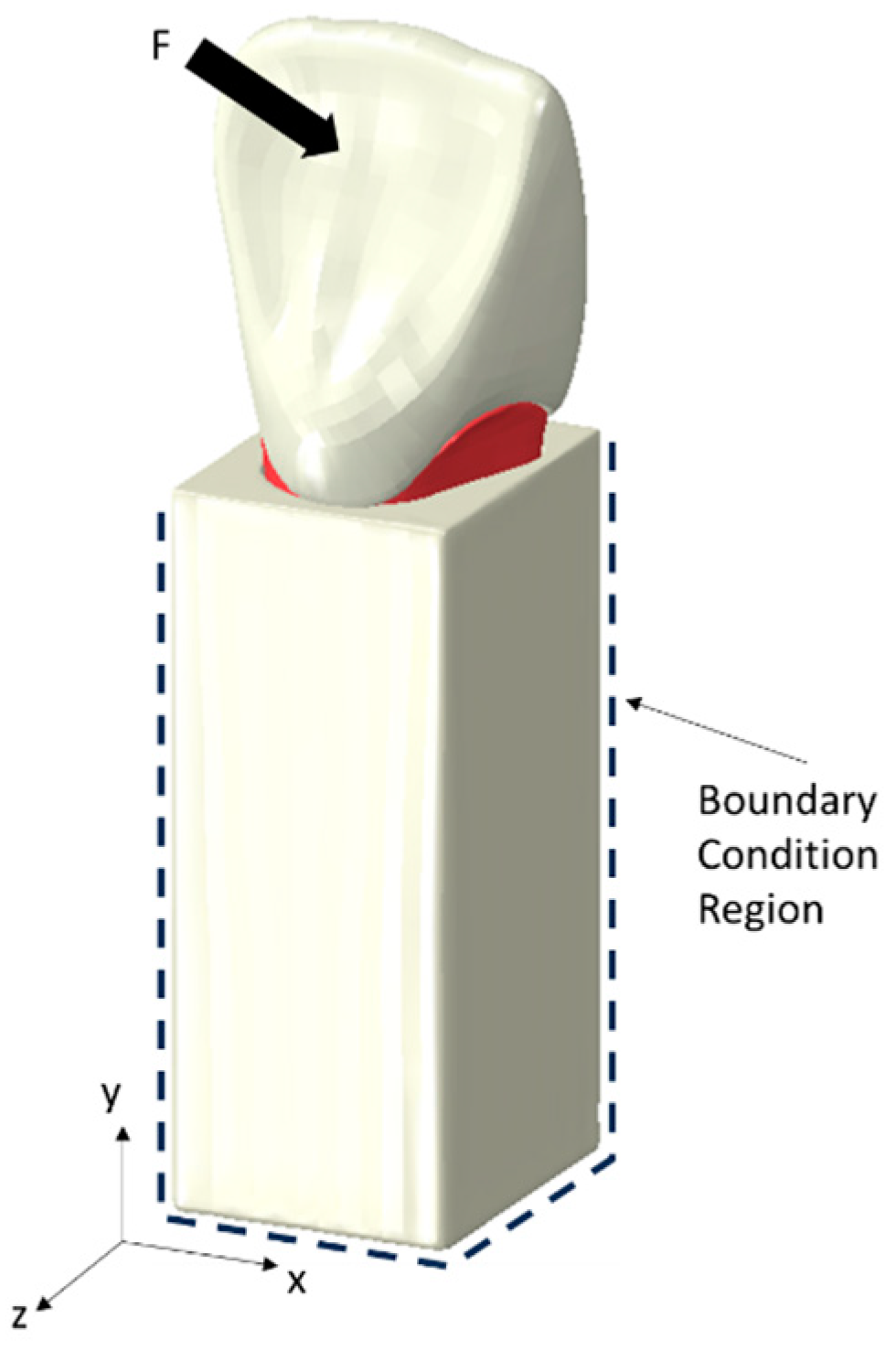
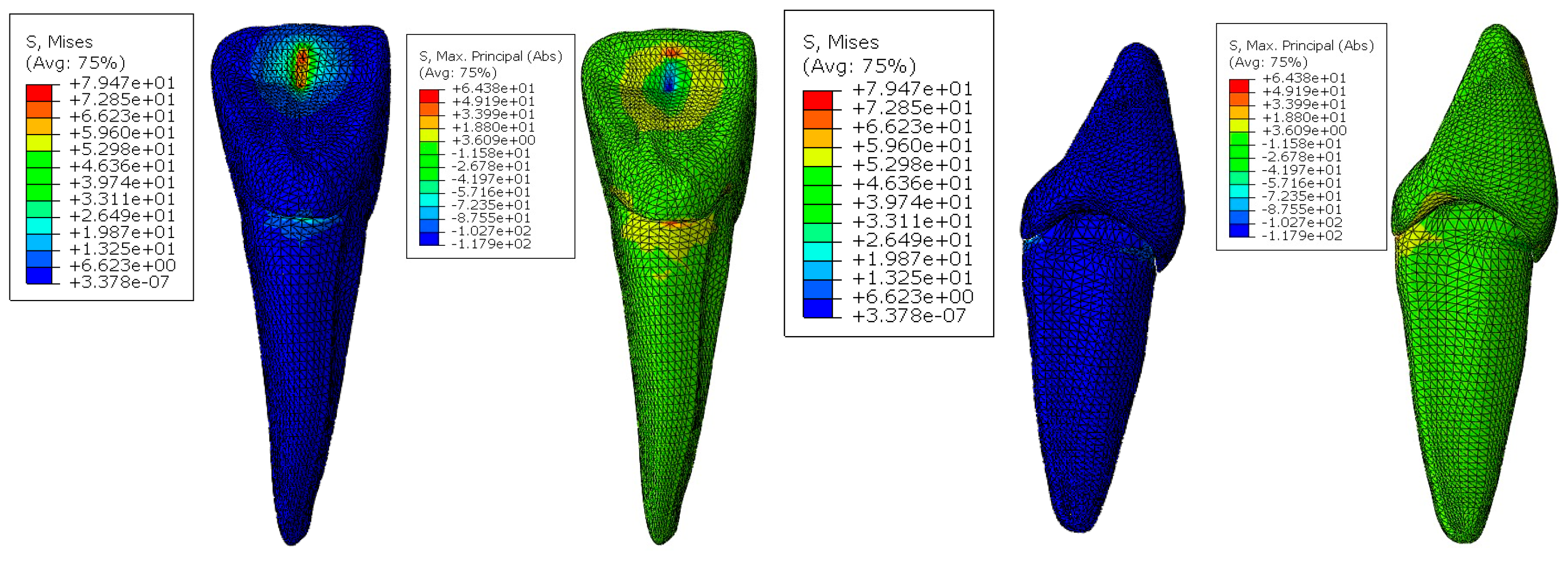
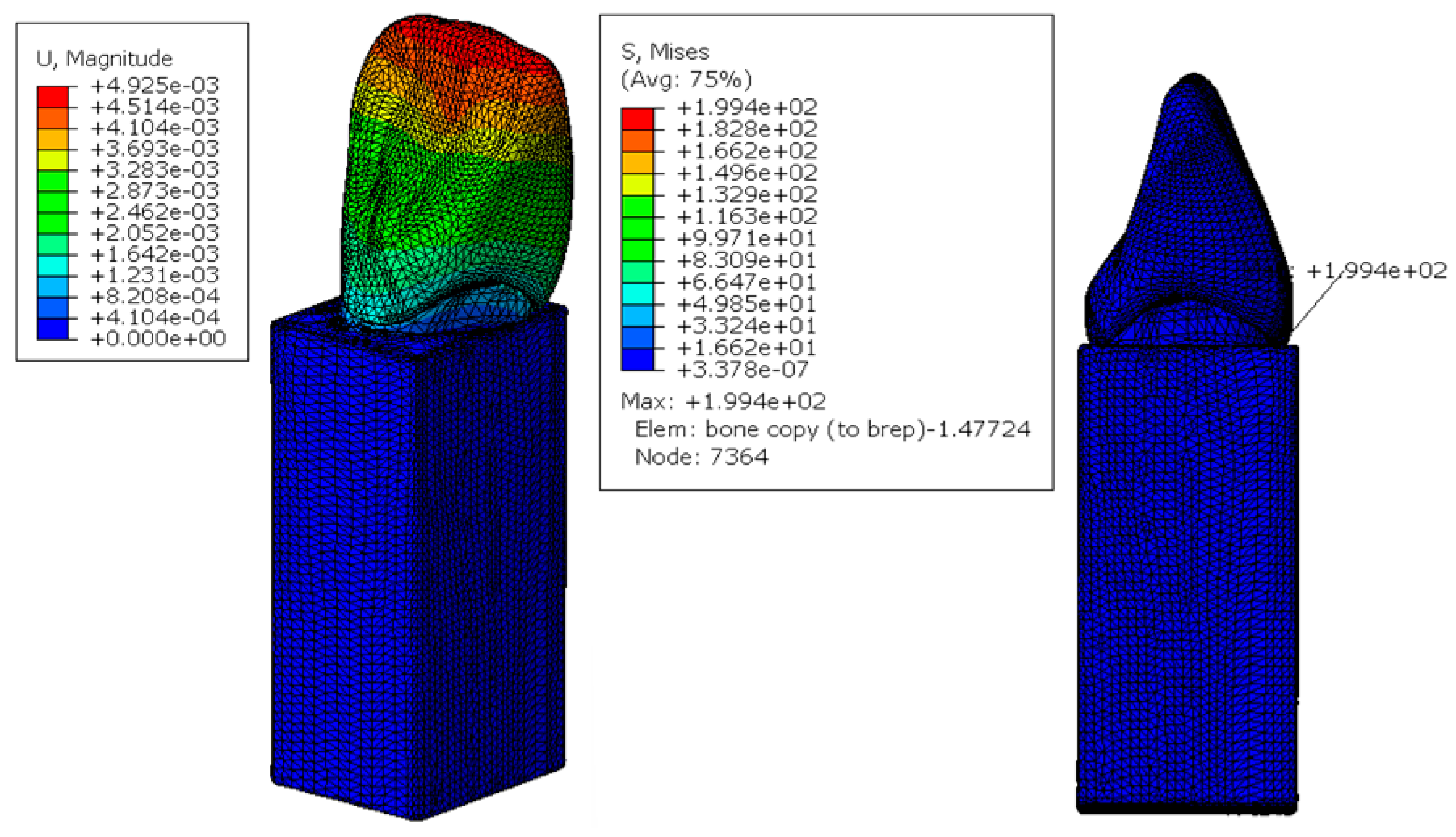
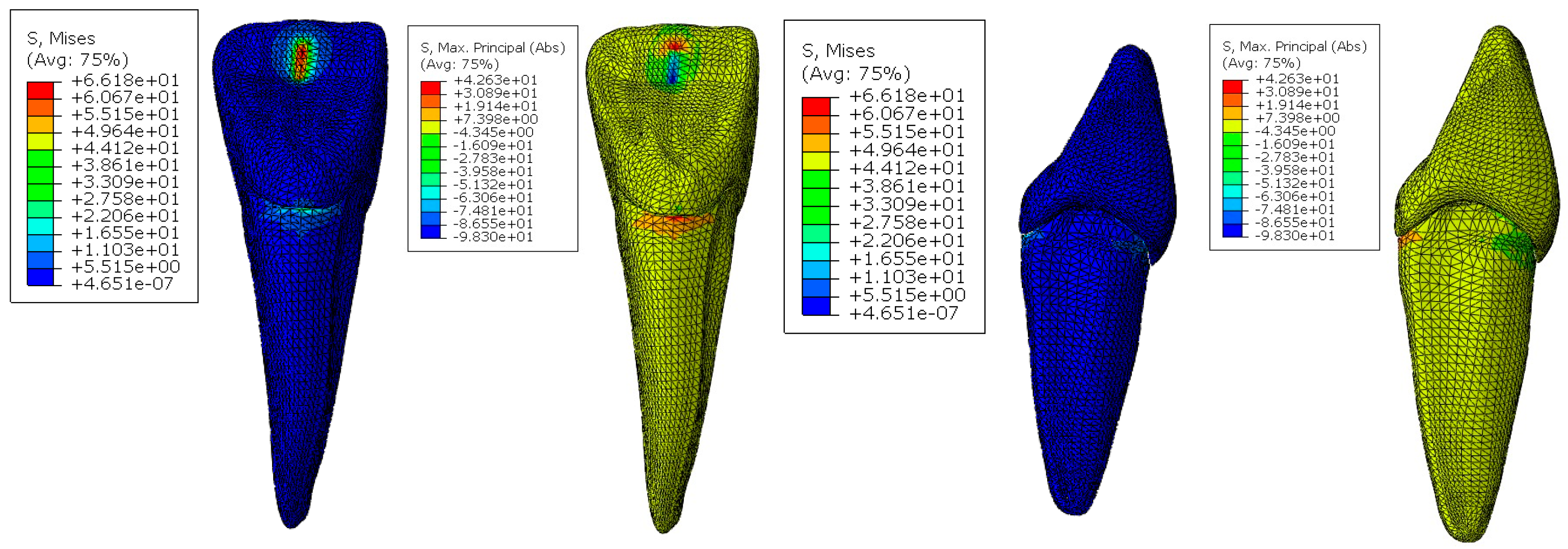
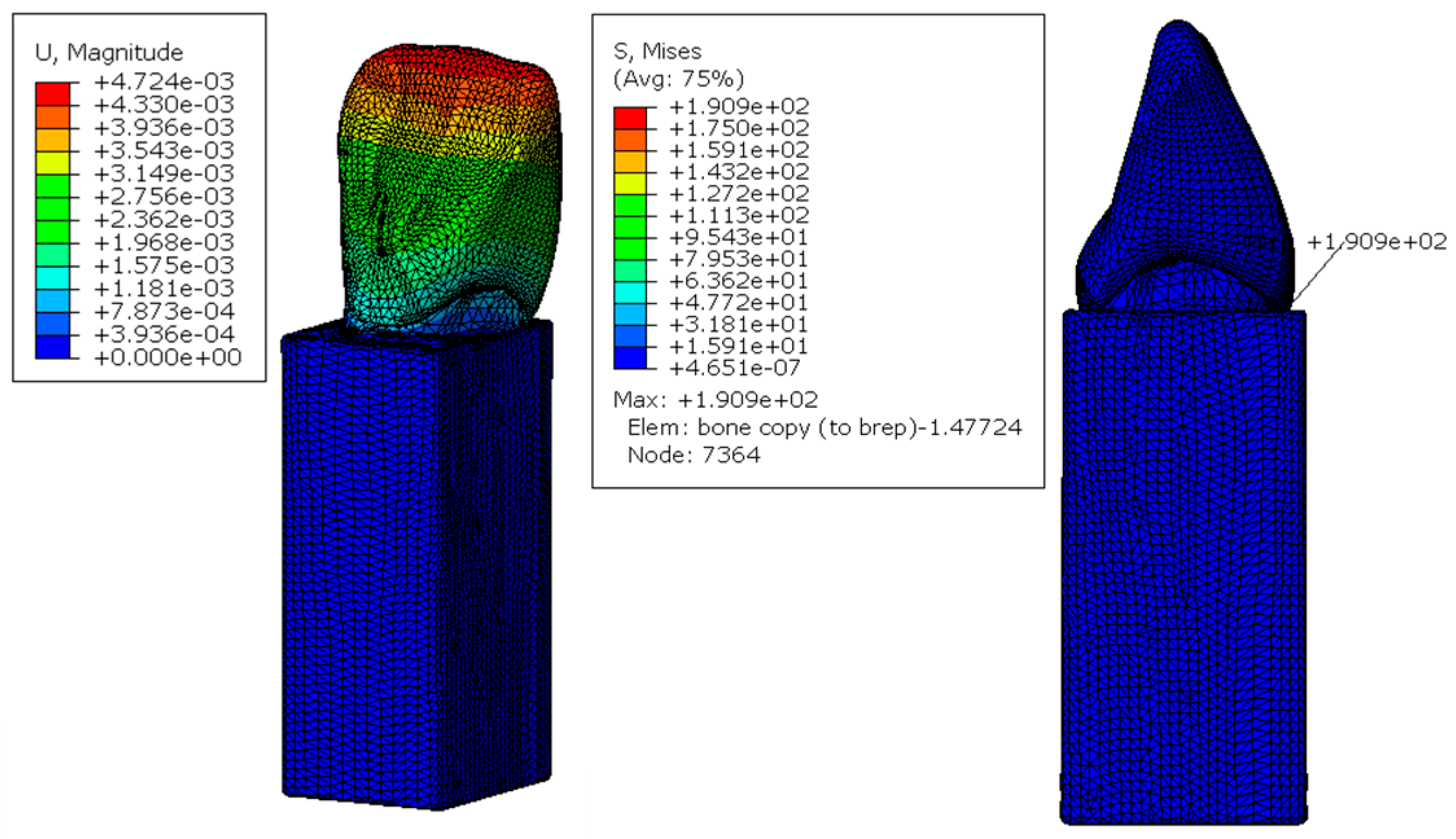
| Material | Young’s Modulus (GPa) | Poisson’s Ratio |
|---|---|---|
| Bone | 13.7 | 0.3 |
| PDL | 0.0689 | 0.45 |
| Root | 18.6 | 0.31 |
| Post Cement | 18.3 | 0.3 |
| Post (PEEK) | 3.95 | 0.3931 |
| Post (High Noble Alloy) | 100 | 0.31 |
| Gutta-Percha | 6.9 × 10−4 | 0.45 |
| Crown Cement | 18.3 | 0.3 |
| Crown (Zirconia) | 250 | 0.32 |
| Component | Element Size (mm) | No. of Elements | Node |
|---|---|---|---|
| No. Nodes | |||
| Crown | 0.5 | 45,246 | 68,222 |
| Bone | 0.5 | 116,642 | 170,358 |
| Crown Cement | 0.4 | 11,728 | 22,881 |
| Post | 0.5 | 19,982 | 31,060 |
| Gutta-Percha | 0.2 | 5607 | 8820 |
| Post Cement | 0.4 | 11,513 | 22,967 |
| Root | 0.5 | 54,607 | 80,895 |
| Total | 265,325 | 405,203 |
| Stresses | |||||
|---|---|---|---|---|---|
| Component | Material | Strength (MPa) | Von Mises (MPa) | Principal Stress (MPa) | FOS |
| Root | Dentin | 86 | 31.77 | 43.82 | 1.96 |
| Post | PEEK | 192 | 19.08 | 0.6456 | 10.01 |
| Crown | Zirconia | 1100 | 79.47 | 50.53 | 13.84 |
| Bone | 199.4 | 225.2 | |||
| Displacement (um) | 4.925 | ||||
| Root | Dentin | 86 | 29.98 | 42.63 | 2.02 |
| Post | High Alloy | 310 | 18.35 | 13.41 | 16.89 |
| Crown | Zirconia | 1100 | 66.18 | 42.01 | 16.62 |
| Bone | 190.9 | 216.5 | |||
| Displacement (um) | 4.724 |
Disclaimer/Publisher’s Note: The statements, opinions and data contained in all publications are solely those of the individual author(s) and contributor(s) and not of MDPI and/or the editor(s). MDPI and/or the editor(s) disclaim responsibility for any injury to people or property resulting from any ideas, methods, instructions or products referred to in the content. |
© 2025 by the authors. Licensee MDPI, Basel, Switzerland. This article is an open access article distributed under the terms and conditions of the Creative Commons Attribution (CC BY) license (https://creativecommons.org/licenses/by/4.0/).
Share and Cite
Alkhallagi, T.S.; Moria, G.A.; Al Khunaizi, D.F.; Alzahrani, M.; Marghalani, T.Y. Stress Distribution in Radicular Dentin with Different Post and Core Materials: A 3D Finite Element Analysis. Appl. Sci. 2025, 15, 3515. https://doi.org/10.3390/app15073515
Alkhallagi TS, Moria GA, Al Khunaizi DF, Alzahrani M, Marghalani TY. Stress Distribution in Radicular Dentin with Different Post and Core Materials: A 3D Finite Element Analysis. Applied Sciences. 2025; 15(7):3515. https://doi.org/10.3390/app15073515
Chicago/Turabian StyleAlkhallagi, Turki S., Ghaida’a A. Moria, Dalya F. Al Khunaizi, Mahmoud Alzahrani, and Thamer Y. Marghalani. 2025. "Stress Distribution in Radicular Dentin with Different Post and Core Materials: A 3D Finite Element Analysis" Applied Sciences 15, no. 7: 3515. https://doi.org/10.3390/app15073515
APA StyleAlkhallagi, T. S., Moria, G. A., Al Khunaizi, D. F., Alzahrani, M., & Marghalani, T. Y. (2025). Stress Distribution in Radicular Dentin with Different Post and Core Materials: A 3D Finite Element Analysis. Applied Sciences, 15(7), 3515. https://doi.org/10.3390/app15073515







